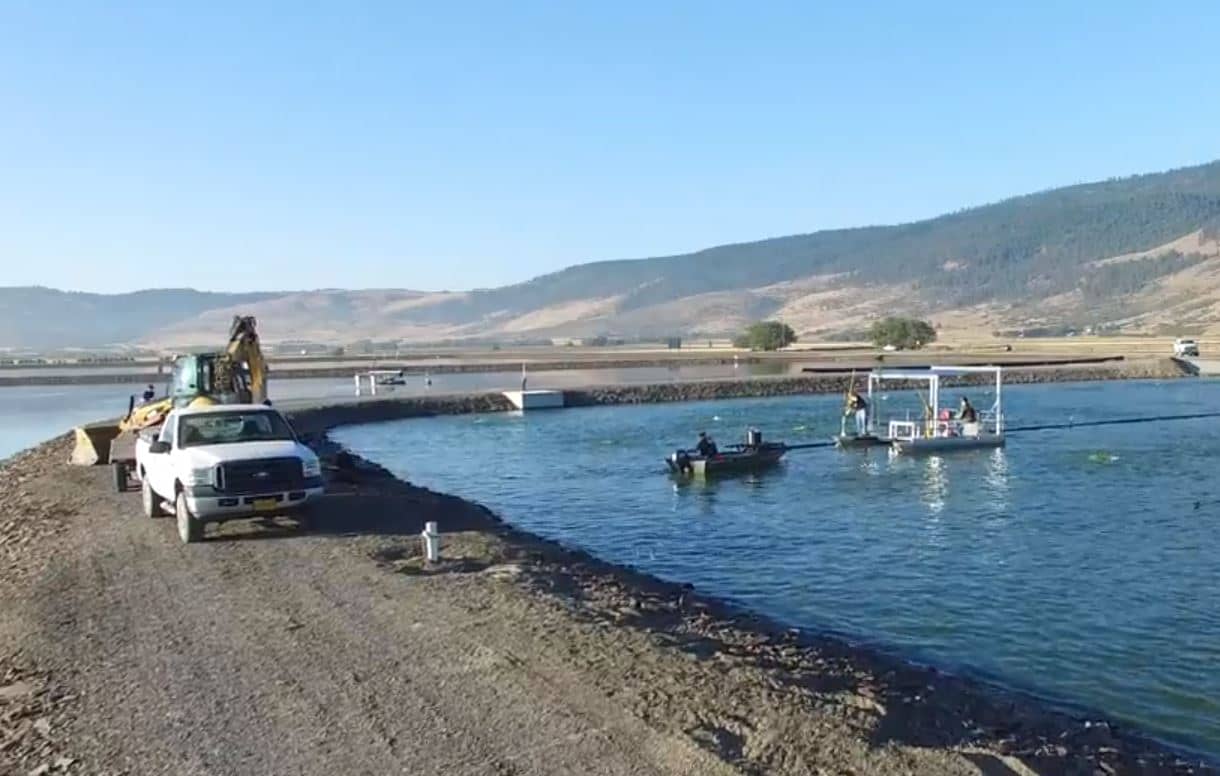A lagoon aeration retrofit can improve treatment and save thousands of dollars in energy, operations, and maintenance costs. Replacing a coarse bubble aeration system with Triplepoint’s lagoon aeration maintains the mixing performance of coarse bubbles and combines it with fine bubble oxygen transfer efficiency to maximize lagoon treatment.
Because Triplepoint aerators are portable, the retrofit can be completed with minimal operational disruption and leverage the existing blower and header infrastructure. La Grande, Oregon, installed our aeration system in just two days and got their system back in compliance.
Watch our video case study and read below for highlights.
Lagoon Case Study: Lagoon Aeration Retrofit
La Grande, Oregon, a city with a population of just over 13,000, is located in the northeast corner of the state. The community’s wastewater is treated by a lagoon system spread over more than 100 acres, including a 3.5 acre aeration cell and a 62 acre secondary treatment cell with surface aerators. Following a 35 acre storage cell, effluent flows to settling cells, tertiary treatment, or a constructed wetland.
The 3.5 acre aeration cell was not performing as required. The coarse bubble aeration system was clogged and failing, leading to very low levels of dissolved oxygen, insufficient treatment, and odors.
While coarse bubble aeration has many benefits, namely good mixing performance, durability, and resistance to surfactants, it has a number of drawbacks.
Problems with Coarse Bubble Aeration
- Inefficient Aeration: Bubble size is the single biggest factor in determining Standard Oxygen Transfer Efficiency (SOTE). Smaller bubbles have more contact area per volume of air and rise more slowly, making them more efficient at transferring oxygen than larger bubbles, which have less surface area and rise quickly. A typical coarse bubble diffuser may produce 1% of SOTE per foot of depth, while a typical fine bubble diffuser may produce about 2% SOTE per foot of depth.
- Difficulty Installing and Accessing: Most coarse bubble systems are anchored to the bottom of the lagoon, requiring the basin to be drained and sludge removed to allow installation and maintenance.
- Clogging Potential: If a coarse bubble diffuser isn’t equipped with backflow sealing, debris will clog the orifice when the air is switched off, causing backpressure issues, a drop in efficiency, and maintenance headaches.
For a closer look, read our article, Lagoon Coarse Bubble Aeration: Pros & Cons.
The Solution: Triplepoint’s Lagoon Aeration
La Grande’s lagoon facility has a design flow of 3.5 million gallons a day and a volume of 12.8 Mgal. Thirty-two Triplepoint aerators were installed into the 11 foot deep, 3.5 acre aeration cell. Each is attached to the existing centrifugal blower and onshore header with submerged laterals via a flexible weighted air line.

With Triplepoint’s aerators, La Grande was able to maintain the coarse bubble mixing performance they required and benefit from the modern oxygen transfer efficiencies of fine bubble aeration. The system’s fine bubble diffusers transfer nearly twice as much oxygen with the same blower input, while the coarse bubble mixing component ensures it is distributed throughout the cell.
Due to Triplepoint aeration’s mixing and oxygen transfer capability, over half of the total BOD reduction in the lagoon system occurs in the aeration cell, which contains just 3.5 percent of the total volume.
About Triplepoint’s Lagoon Aeration
Triplepoint’s aerators, which feature patented Double Bubble Technology™, combine the mixing capabilities of coarse bubbles with the superior oxygenation of fine bubbles in a modular, portable unit. Our diffusers provide:
- Robust mixing—Coarse bubbles are released at the bottom of the static tube, creating a draft that pulls water and liquefied organic matter up from the floor, thoroughly churning and circulating the entire water column to keep solids in suspension and prevent sludge accumulation.
- Efficient aeration—Fine bubble diffusers surround the static tube, maximizing oxygen transfer efficiency while minimizing energy consumption.
- Easy installation—Self-weighted and portable, aerators are quickly installed from the surface with no system downtime.
- Low maintenance—Our aerators have no submerged moving parts to clog or malfunction. The anti-fouling design, with self-checked diffusers and self-cleaning EPDM membranes, means maintenance is kept to a minimum.
- Energy efficiency—Our aerators are 30–50% more energy efficient than surface aerators, reducing energy demands and expense.
To learn more about how a lagoon aeration retrofit with Triplepoint aeration can improve treatment and save thousands of dollars in energy, operations, and maintenance costs, download our brochure.

